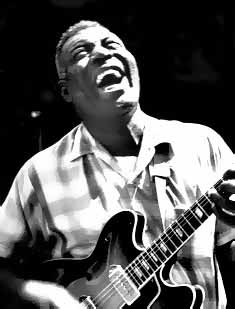
White historians usually deserve the blame for overmythologizing blues singers. But James Segrest and Mark Hoffman, co-authors of the biography "Moanin' at Midnight: The Life and Times of Howlin' Wolf," have little to fear.
Howlin' Wolf's feral act led everyone to mythologize him: black and white, musicians and laymen, and especially Wolf himself. Here the biographers repeat the myths, and lay them on a chronological grid.
In this book's quoted descriptions, Howlin' Wolf (1910-76) stood anywhere from 6 foot 3 to 6 foot 8 and glowed darkly, like motor oil. The singer Ronnie Hawkins heard Wolf's serrated, gravelly voice as "stronger than 40 acres of crushed garlic." The poet Philip Larkin likened it to "Coleridge's demon love." Wolf left scattered impressions of sweetheart and abuser, wise owl and dummy: "two steps ahead of an idiot," said the recording engineer Malcolm Chisholm; "close to being a genius," said the saxophonist Fat Sonny Williams.
He could hold up the back end of a car to change a flat tire. He wore Size 14 shoes, or, according to the notes of an Army doctor, 16. (The same doctor noted his "tendency to destroy furniture," and diagnosed him with "psychoneurosis.")
Onstage Wolf transmitted imposing hokum. He bugged his eyes out, gestured toward his crotch more than Eminem, crawled on all fours while singing his song "Tail Dragger," shinnied up curtains. Johnny Shines, the blues singer, is quoted about encountering Wolf for the first time in 1932: "I was afraid of Wolf. Just like you would be of some kind of beast or something. . . . And at that time Wolf had the most beautiful skin anybody ever seen in your life, look like you can just blow on it and it'd riffle."
Naturally Shines intimated that Wolf had made a deal with the devil. But he went further: "As far as I knew he could have crawled out of a cave, a place of solitude, after a full week's rest, to serenade us."
The world's astonishment at Wolf all strikes the same note of gabby speechlessness, and the authors have put far too much of it in. (Like many pop-music biographers they are full-blooded believers; it's as if skepticism would melt their hero.) But by debriefing nearly 150 musicians who knew him and drawing on secondary sources as well, and by the subtle imposition of a few overriding themes, they have done important work in bringing Wolf down a little closer to life size.
Born Chester Arthur Burnett in the hamlet of White Station, Miss., and cast away by his mother on an indeterminate day of his youth for an indeterminate reason, Wolf found a bed in the house of his great-uncle some miles away. That was about the only comfort the uncle offered. The book's description of these years reads like a blueprint for destroying a child. Wolf arrived in the Mississippi Delta to work on plantations at age 13, and met up again with his father, who gave him a guitar at 18.
In one sense Wolf wasted little time. The singer and guitarist Charley Patton was living on a nearby plantation, and Wolf studied him up and down: his guitar tunings, his repertory, his rhythm, his stagecraft. Wolf apprenticed with him, playing the dangerous juke joints of the Delta.
But in another sense the big time almost slipped away from him. As early as Page 85 — where Wolf lights out for a better career in West Memphis — the reader is confronted by a middle-aged musician who had now played professionally for 20 years.
Mr. Segrest and Mr. Hoffman render Wolf's performing life in Memphis and Chicago pretty well — club after club, thick with alcohol, violence and anxiety over getting paid — as they do his subsequent international touring after the early-60's blues revival. But the authors pile up the most useful information around two of Wolf's more fraught male relationships. (His long marriage to Lillie Handley seems to have been relatively secure.)
With Muddy Waters, Wolf enacted a combination of a put-on and a true rivalry. Waters came to Chicago in 1942, Wolf in 1953; they eventually became the twin towers of blues there. Still, they were character opposites. Waters was graceful, generous, and as Robert Gordon's recent biography pointed out, many of his charges went on to become bandleaders. Wolf was heavy-footed and jealous, and a tight-fisted boss who ordered his musicians not to drink. Waters loved Fats Waller. Wolf called jazz "blee-blop" and fined his guitarist for playing it.
The other decisive relationship explored in the book is with Hubert Sumlin, Wolf's longest-lasting lead guitarist. Wolf felt paternal to Mr. Sumlin and gave him 20 years of mixed experience: fighting to win him back when Mr. Sumlin joined Waters's band, humiliating him in public and so on to the end.
Mr. Sumlin, still living and playing, talked to the authors at length, and his stories become crucial. It is through what he says, and a little bit of what he doesn't say, that we learn of Wolf's mixture of pride and insecurity. One drop of that insight is worth 50 stories about a hoodoo giant who could lift the back of cars.
MOANIN' AT MIDNIGHT
The Life and Times of Howlin' Wolf
By James Segrest and Mark Hoffman
Illustrated. 397 pages. Pantheon Books. $26.95.


Nenhum comentário:
Postar um comentário